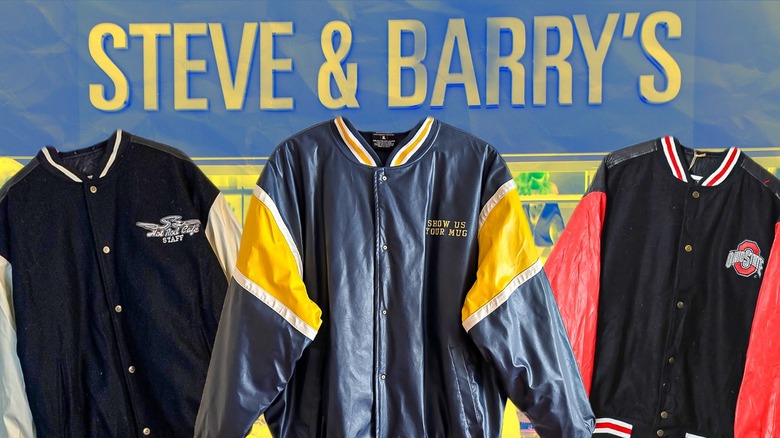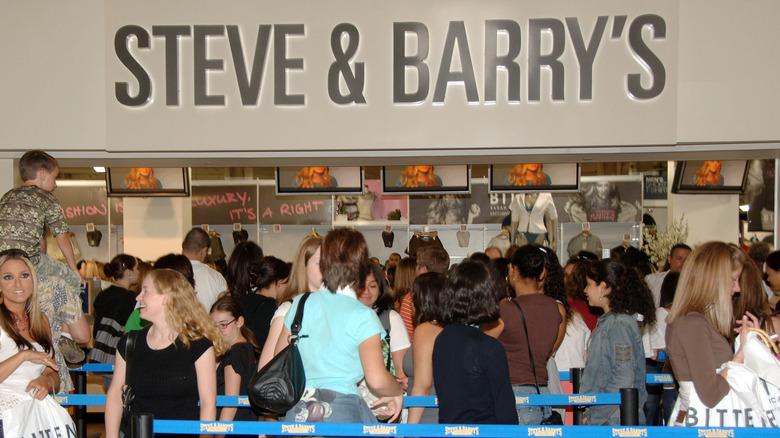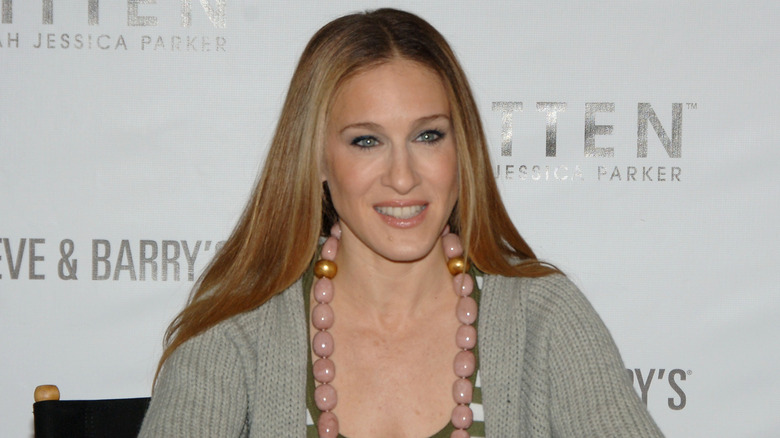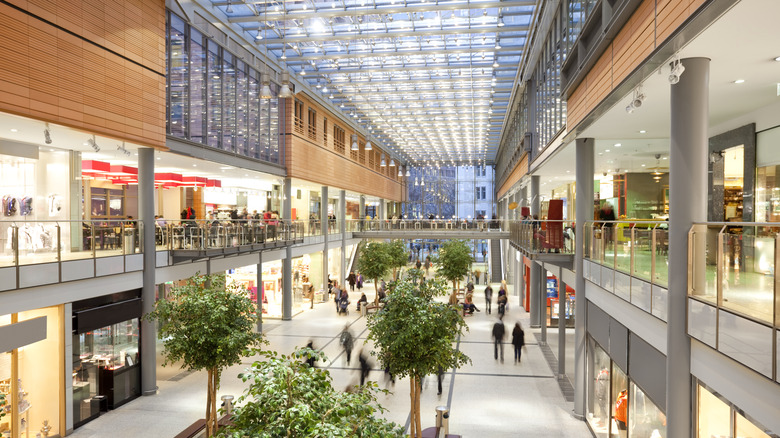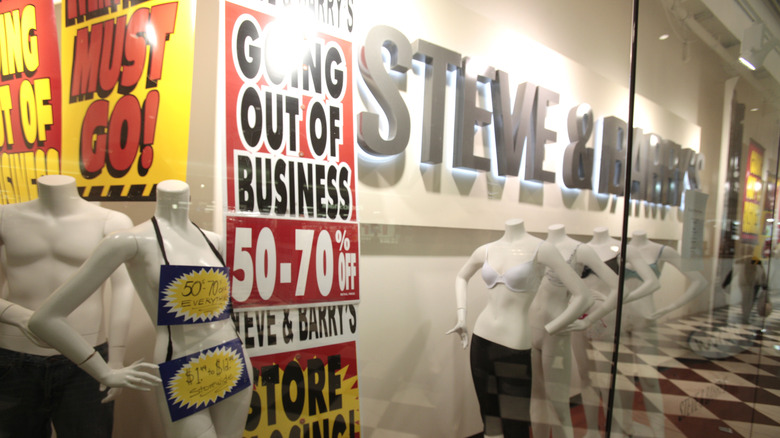Whatever Happened To Steve & Barry's?
In the 2000s, a trip to the mall for many cash-strapped teens and college students meant a trip to Steve & Barry's. The brand — founded by Steven Shore and Barry Prevor in 1985 — was first known for its college-themed apparel. University tees and varsity sweatshirts were priced at a discount, which made it easy for the duo to compete with nearby campus bookstores. Flash forward to 1998 when Steve & Barry's opened its first mall location, sparking a new trajectory for the company.
By 2005, college goods made up less than one-third of total sales for the brand, per Forbes. Steve & Barry's had expanded its clothing line to include jeans, jackets, button-up shirts, and other goods, and all still at an affordable price. In fact, the majority of the brand's products sold for less than $11, according to Reuters.
The bargains were unbeatable for many shoppers, which led to the store's meteoric growth in the mid-to-late '00s. At its peak, the chain had 276 stores across the country, often located in malls and shopping centers. Unfortunately, the qualities that initially helped Steve & Barry's grow eventually contributed to the company's downfall.
The brand's penny-pinching reputation
While it took Steve & Barry's years to become a household name, once the business took off, it showed no signs of stopping. In 2005, the brand was crowned the "Hot Retailer of the Year" by the International Council of Shopping Centers. In 2007, Brandweek called the company a "Marketer of the Year." Steve & Barry's was winning over both industry leaders and budget-conscious shoppers — a fact its founders took pride in. "In many ways we're changing the world," Barry Prevor told the Associated Press (via Deseret News) in 2006. "McDonald's changed hamburgers, Home Depot changed hardware. Basically we're saying it's the same thing with clothes. There's no reason people have to pay five times the price for the items we're selling."
As Retail Forward's Lois Huff shared, Steve & Barry's was likely able to cut costs by sourcing its garments from unconventional countries, such as Madagascar. However, it skimped in other areas, too, including marketing. "[W]e do not do any significant advertising; customers arrive at our door by word of mouth or because they read about us in 'The New York Times' or Glamour Magazine or saw us on 'Oprah' or 'The Today Show,'" Gary Sugarman, Steve & Barry's COO, explained to Retail Info Systems in 2007.
The company then appeared to pass these savings down to customers with its tiny margins — according to estimates, Steve & Barry's marked-up merchandise by just 2% to 20%, compared to the industry average of 54%.
Steve & Barry's leveraged celebrity collaborations
During the 2000s, perhaps no one had more influence than celebrities and famous athletes, and Steve & Barry's found a way to cash in on that. Famous actresses Sarah Jessica Parker (known for pioneering trends as Carrie Bradshaw) and Amanda Bynes both had their own clothing collections at the chain store, as well as athletes such as Venus Williams.
Arguably the biggest and most memorable celebrity collaboration was with basketball player Stephon Marbury. In 2006, the New York Knicks point guard launched the Starbury basketball sneaker, sold exclusively at Steve & Barry's for a shockingly affordable $14.98. "It costs less than $14.98 to make, sure. Any shoe, it cost less than $14 to make a shoe," Marbury told The Denver Post. "But all the prices are marked up. We don't do all the advertising that they do. We do word of mouth. I'll call (the media) and do an interview. You're not getting (other) guys to call you and do an interview. I'm behind my project."
The Starbury was more than just a cheap and stylish sneaker — it competed with premium basketball shoes, even going on to win Footwear News' Launch of the Year award in 2006. When The Denver Post asked Marbury about the affordable shoe's success, he shared, "I sold like 3 million pairs of sneakers already. You can make money off of it."
The company's business model started to show cracks
Steve & Barry's business model, built on cutting costs and taking risks, may have been too ambitious to sustain for long. In his 2007 interview with Retail Info Systems, COO Gary Sugarman explained, "We've opened 70 stores in the last 12 months, and expect to open 70 to 75 more this calendar year, and we haven't yet found a bad location for us. We're largely in shopping malls, but have begun to expand into strip malls, lifestyle malls and freestanding locations. We're in the center of Manhattan, we're in Peoria, in Allentown, in Los Angeles – big markets, small markets, urban and rural markets – and we've succeeded in every one."
By the following year, however, the company was struggling — and critics were finding faults in the retailer's approach to real estate. "During their extreme growth mode, which was too ambitious, they took on some leases at the wrong price and wrong location," Douglas Teitelbaum, managing principal of Bay Harbour Management, revealed to The Seattle Times. A CBS News write-up elaborated further, pointing out that Steve & Barry's negotiated for low rental costs and high allowance fees from malls. Those allowance fees may have earned the company more revenue than actual clothing sales, a strategy that investment expert Mike Shedlock accused of being a "Ponzi scheme" (later, a property owner filed a lawsuit for fraud after Steve & Barry's misused $1 million given for store renovations, per New York Post).
Bankruptcy and the end of the brand
With a questionable business strategy and slim sales margins, Steve & Barry's started to crumble in 2008, right when the Great Recession struck the economy. A New York Times article states that the company filed for bankruptcy in July 2008, with the founders blaming the "generally poor environment for apparel retailers" of the time for Steve & Barry's financial trouble. By August, Bay Harbour Management and York Capital Management bought out the company and initially planned to continue regular operations at some locations. A CBS News report even noted that Steve & Barry's was opening a new flagship location in New York City while other locations were being shuttered.
However, just three months later, the new owners confirmed they would liquidate any remaining Steve & Barry's stores due to poor sales and a lack of funds. The economic downturn could have been blamed for the brand's demise, but some experts claimed Steve & Barry's set itself up for failure. "This business growth was obsessively focused on real estate growth and using recognizable faces to drive brand growth," Matthew Katz, a managing director at restructuring firm AlixPartners, told Reuters of Steve & Barry's strategy. "In go-go growth years, the business was rewarded. However the underlining business processes and controls were not put in place and as the markets turned, this unraveled quickly."
